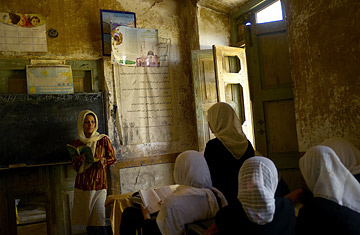
Seventh-grade English teacher Najia Zamani is a rarity: only 28% of Afghan teachers are women
(2 of 2)
"In Afghan culture, women are seen as the repository of family honor, and the education of girls--whether in terms of the design of school buildings or in the way in which classes are conducted--needs to reflect that reality," says Matt Waldman, the Afghan policy adviser for Oxfam, which released a damning report in 2006 on the state of education in Afghanistan. It shows that the ratio of boys to girls in primary school is roughly 2 to 1, but by the time girls enter secondary school (and puberty), the ratio drops to four boys for every girl. In more than 80% of rural districts, there are no girls in secondary school at all. Overall, only 10% of girls in school actually obtain a diploma.
The Oxfam report identifies another critical factor holding back girls' education: only 28% of the country's accredited teachers are women. "It is absolutely crucial to increase the number of female teachers if you want to see more girls in school," says Waldman.
But if there are so few girls completing their education, how do you grow the next generation of female teachers? The first answer, says Atmar, is to remove all other impediments to girls' going to school. That means constructing new buildings so classes aren't held in the open. In the meantime, unconventional inducements can help. In a successful program in some rural areas, girls are given a free ration of oil and flour at the end of every month. This encourages their poor families to keep sending them to school. Increasing teachers' salaries would convince more parents that their daughters should take up the profession. Teachers with high school diplomas earn $50 to $75 a month, a tiny return on investment for families whose daughters could be spending those 12 years at home weaving carpets, tending the fields or taking care of the household.
While struggling to build the new infrastructure, educators must also contend with Afghanistan's old demons: the Taliban is making a comeback in several provinces and reimposing its rules. In little over a year, 130 schools have been burned, 105 students and teachers killed and 307 schools closed down because of security concerns. Many of those schools were for girls, and most of them were in the southern provinces, where a Taliban-driven insurgency has made it nearly impossible to secure the schools. But the violence is creeping closer to the capital. In June 2007, two gunmen on a motorcycle shot dead three female students coming out of high school in the central province of Logar, a 1 1⁄2-hour drive from Kabul.
But if Afghanistan has any reason for hope, it is the sheer determination of the girls who do have a chance to go to school. Lida Ahmadyar, 12, whose sister was one of the girls killed in the Logar shooting, has started going back to school. Every day she walks past the spot where her sister died, but she clings to her dream of becoming a doctor. "I am afraid," she says. "But I like school because I am learning something, and that will make me important. With education, I can save my country." If enough of Afghanistan's girls get the chance, they may do just that.
